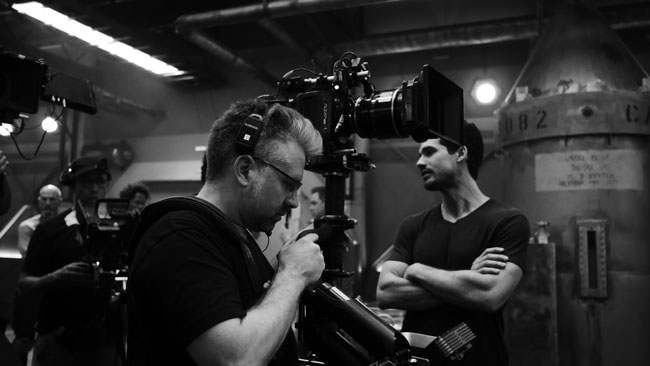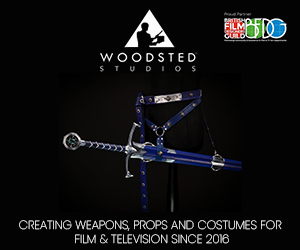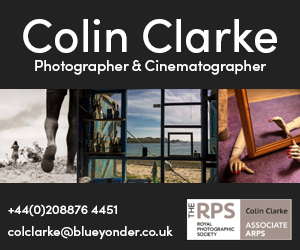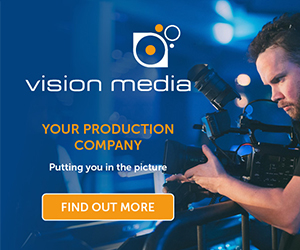Broadcast News
17/01/2018
Cooke Lenses Deployed For 'The Expanse'

Cooke Optic's 5/i Primes lenses have been used on set to film season 3 of SyFy drama The Expanse.
In 2014, Syfy commissioned 10 one-hour episodes of The Expanse; to this day, it remains the most expensive show the channel has ever produced. Based on the book series collectively known as The Expanse, written by Daniel Abraham and Ty Franck (under the pen name James S. A. Corey), critics highlighted the series' visuals, lensed by Jeremy Benning, CSC.
When the series commenced airing on Syfy in December 2015, the network ordered 13 episodes for season 2 (premiering 1 February 2017), and then followed with a renewal for a 13-episode third season to air in 2018, which wrapped production on 5 December 2017.
The Expanse is primarily shot via 2-cameras using ARRI ALEXA Minis at 23.98fps, ProRes 4444 UHD 16:9 with a third ALEXA Mini brought in when needed.
Jeremy Benning, CSC, and the Director of Photography for all three seasons of the show, said: "I love Cooke lenses. I've been a long-time user of Cooke's S4/i, miniS4/i and 5/i lenses, and for The Expanse, I wanted a gritty, hard, but human look – Cooke 5/i primes were the natural choice from day one. With digital cameras, the Cooke 5/i lenses deliver something gentler that takes the edge off the crispness – it's still super sharp, but I get rounder and more gentle faces, great defocus, and wonderful fall off between foreground and background. DPs always talk about 'The Cooke Look' and for me that means a creamier, softer, three-dimensionality with great bokeh."
Benning prefers not to use any filtering for The Expanse, having done some tests during season one, although he will make use of the occasional 1/16th, Classic Soft. A major percentage of the show's visuals are in-camera, with VFX being used for set extensions and exterior space shots. For example, in seasons two and three, there are very dark, almost cave-like environments that needed to show bioluminescent particles and walls. Using ultraviolet pigment built into the sets and UV light to fluoresce and almost totally light the set, Benning was able to capture an ethereal look that would just need some VFX augmenting in post. This UV effect meant extremely low light levels on set.
"The Expanse is visually different from a lot of typical television science fiction," Benning continued. "The series has a hard-edge look without being clinical. The sets are often techie and harsh, and the lenses help take some of that edge off and add more character, sort of a graphic novel look to the images."
Production of The Expanse is 90 percent studio based, with one location day per episode. The sets are mostly complete 360-degree environments with walls, floors, and ceilings. Benning worked closely with the show's production designer Tony Ianni to work lighting into the sets, selecting the type of lighting and the materials the light would pass through. The sets are virtually entirely lit practically.
"Primarily, we use LED ribbons mixed with some various film-based and theatrical/rock-and-roll lighting," he explained. "We did extensive testing to make sure we had no flicker or any other issues. During season two, we started making our own lights for our standing sets – it's just so much more economical to build rather than to rent, and we can replicate most things the rental fixtures can do."
For The Expanse, Benning had the full 9-lens set of 5/i primes, consisting of 18mm, 25mm, 32mm, 40mm, 50mm, 65mm, 75mm, 100mm, and 135mm with T1.4 speed, shared between the cameras, with all lenses being used. Benning also used Cooke's /i Technology lens metadata protocol, which enables ARRI's Lens Data System (LDS) in the ALEXA Mini to automatically record key lens data for every frame shot and provide it to the show's multiple visual effects vendors digitally. This includes focus, iris, and zoom data, so that visual effects used to extend the sets or add in a new background can be seamlessly tracked to match the in-camera element.
"My goal is to keep the audience in the world of the show, making them believe that what they see is real," said Benning. "I often shot the Cookes wide open, to take the edge off the 'set' aspect of the environments, keeping the focal point on the actors' eyes. That takes the emphasis away from the artificiality of a space craft set. With a defocused background, everything blends so it helps sell the idea of being in a real place – that's our main goal. Cookes make the background look more like a painting than a set."
Image: Jeremy Benning on set. Image credit: David Grossman.
www.cookeoptics.com
(JP/LM)
In 2014, Syfy commissioned 10 one-hour episodes of The Expanse; to this day, it remains the most expensive show the channel has ever produced. Based on the book series collectively known as The Expanse, written by Daniel Abraham and Ty Franck (under the pen name James S. A. Corey), critics highlighted the series' visuals, lensed by Jeremy Benning, CSC.
When the series commenced airing on Syfy in December 2015, the network ordered 13 episodes for season 2 (premiering 1 February 2017), and then followed with a renewal for a 13-episode third season to air in 2018, which wrapped production on 5 December 2017.
The Expanse is primarily shot via 2-cameras using ARRI ALEXA Minis at 23.98fps, ProRes 4444 UHD 16:9 with a third ALEXA Mini brought in when needed.
Jeremy Benning, CSC, and the Director of Photography for all three seasons of the show, said: "I love Cooke lenses. I've been a long-time user of Cooke's S4/i, miniS4/i and 5/i lenses, and for The Expanse, I wanted a gritty, hard, but human look – Cooke 5/i primes were the natural choice from day one. With digital cameras, the Cooke 5/i lenses deliver something gentler that takes the edge off the crispness – it's still super sharp, but I get rounder and more gentle faces, great defocus, and wonderful fall off between foreground and background. DPs always talk about 'The Cooke Look' and for me that means a creamier, softer, three-dimensionality with great bokeh."
Benning prefers not to use any filtering for The Expanse, having done some tests during season one, although he will make use of the occasional 1/16th, Classic Soft. A major percentage of the show's visuals are in-camera, with VFX being used for set extensions and exterior space shots. For example, in seasons two and three, there are very dark, almost cave-like environments that needed to show bioluminescent particles and walls. Using ultraviolet pigment built into the sets and UV light to fluoresce and almost totally light the set, Benning was able to capture an ethereal look that would just need some VFX augmenting in post. This UV effect meant extremely low light levels on set.
"The Expanse is visually different from a lot of typical television science fiction," Benning continued. "The series has a hard-edge look without being clinical. The sets are often techie and harsh, and the lenses help take some of that edge off and add more character, sort of a graphic novel look to the images."
Production of The Expanse is 90 percent studio based, with one location day per episode. The sets are mostly complete 360-degree environments with walls, floors, and ceilings. Benning worked closely with the show's production designer Tony Ianni to work lighting into the sets, selecting the type of lighting and the materials the light would pass through. The sets are virtually entirely lit practically.
"Primarily, we use LED ribbons mixed with some various film-based and theatrical/rock-and-roll lighting," he explained. "We did extensive testing to make sure we had no flicker or any other issues. During season two, we started making our own lights for our standing sets – it's just so much more economical to build rather than to rent, and we can replicate most things the rental fixtures can do."
For The Expanse, Benning had the full 9-lens set of 5/i primes, consisting of 18mm, 25mm, 32mm, 40mm, 50mm, 65mm, 75mm, 100mm, and 135mm with T1.4 speed, shared between the cameras, with all lenses being used. Benning also used Cooke's /i Technology lens metadata protocol, which enables ARRI's Lens Data System (LDS) in the ALEXA Mini to automatically record key lens data for every frame shot and provide it to the show's multiple visual effects vendors digitally. This includes focus, iris, and zoom data, so that visual effects used to extend the sets or add in a new background can be seamlessly tracked to match the in-camera element.
"My goal is to keep the audience in the world of the show, making them believe that what they see is real," said Benning. "I often shot the Cookes wide open, to take the edge off the 'set' aspect of the environments, keeping the focal point on the actors' eyes. That takes the emphasis away from the artificiality of a space craft set. With a defocused background, everything blends so it helps sell the idea of being in a real place – that's our main goal. Cookes make the background look more like a painting than a set."
Image: Jeremy Benning on set. Image credit: David Grossman.
www.cookeoptics.com
(JP/LM)
Top Related Stories
Click here for the latest broadcast news stories.
20/06/2017
Cooke Lenses Used On Set Of The Little Mermaid
Cooke Optics' S4/i lenses have been selected to film the live action remake of The Little Mermaid. The movie, inspired by the Hans Christian Andersen
Cooke Lenses Used On Set Of The Little Mermaid
Cooke Optics' S4/i lenses have been selected to film the live action remake of The Little Mermaid. The movie, inspired by the Hans Christian Andersen
04/03/2013
Complete Set Of Cooke Speed Panchro Lenses To Launch At NAB 2013
NAB 2013 sees the launch of a service to re-engineer a complete set of 18mm 25mm, 32mm, 40mm, 50mm, 75mm and 100mm Cooke Speed Panchro lenses. Equippi
Complete Set Of Cooke Speed Panchro Lenses To Launch At NAB 2013
NAB 2013 sees the launch of a service to re-engineer a complete set of 18mm 25mm, 32mm, 40mm, 50mm, 75mm and 100mm Cooke Speed Panchro lenses. Equippi
14/11/2007
Cooke RED Set Released From Precision Lenses Manufacturer
Cooke Optics Ltd., a leading manufacturer of precision lenses for the motion picture industry, has announced the Cooke RED Set, a package of four stan
Cooke RED Set Released From Precision Lenses Manufacturer
Cooke Optics Ltd., a leading manufacturer of precision lenses for the motion picture industry, has announced the Cooke RED Set, a package of four stan
12/04/2018
Few Lens Optics For Decades, Then Came The Large Digital Sensors
As software takes control of virtually every production and delivery function, cameras and lenses have reached the stage of looking magnificent as the
Few Lens Optics For Decades, Then Came The Large Digital Sensors
As software takes control of virtually every production and delivery function, cameras and lenses have reached the stage of looking magnificent as the
19/04/2011
Cooke Optics Celebrates Successes With 5/i, S4 And Panchro Lenses At NAB
Cooke Optics, a manufacturer of precision lenses for the motion picture industry, celebrated the continuing success of its lens sets - the top-of-the-
Cooke Optics Celebrates Successes With 5/i, S4 And Panchro Lenses At NAB
Cooke Optics, a manufacturer of precision lenses for the motion picture industry, celebrated the continuing success of its lens sets - the top-of-the-
06/08/2014
Riedel Set For SET 2014
Riedel is showcase a range of its products at this year's SET Expo in Sao Paulo. MediorNet MetroN - The MediorNet family of real-time networks has bee
Riedel Set For SET 2014
Riedel is showcase a range of its products at this year's SET Expo in Sao Paulo. MediorNet MetroN - The MediorNet family of real-time networks has bee
21/09/2022
Cooke Optics Announces Major Investments In Facilities
Cooke Optics has majorly investment in two important facilities and several new staff appointments to support its ongoing global growth. Crest Rise, a
Cooke Optics Announces Major Investments In Facilities
Cooke Optics has majorly investment in two important facilities and several new staff appointments to support its ongoing global growth. Crest Rise, a
03/11/2023
Cooke Optics To Showcase Lenses At EnergaCAMERIMAGE 2023
Cooke® Optics is set to wow audiences at EnergaCAMERIMAGE 2023 as it showcases the versatility of its cutting-edge lenses by bridging the gap between
Cooke Optics To Showcase Lenses At EnergaCAMERIMAGE 2023
Cooke® Optics is set to wow audiences at EnergaCAMERIMAGE 2023 as it showcases the versatility of its cutting-edge lenses by bridging the gap between
02/06/2023
Cooke Optics 60mm, 90mm And 150mm Macro/i FF 1:1 Lenses Now Available
Cooke Optics has announced that 60mm, 90mm and 150mm Macro/i FF 1:1 lenses are now available to order as a full set. The set of three spherical compli
Cooke Optics 60mm, 90mm And 150mm Macro/i FF 1:1 Lenses Now Available
Cooke Optics has announced that 60mm, 90mm and 150mm Macro/i FF 1:1 lenses are now available to order as a full set. The set of three spherical compli
21/03/2023
Cinematographer Ksenia Sereda Selects Cooke S4/i Spherical Lenses
Cooke Optics has announced that its globally renowned Cooke S4/i spherical lenses were the tool of choice for cinematographer Ksenia Sereda to shoot T
Cinematographer Ksenia Sereda Selects Cooke S4/i Spherical Lenses
Cooke Optics has announced that its globally renowned Cooke S4/i spherical lenses were the tool of choice for cinematographer Ksenia Sereda to shoot T
15/03/2023
Cooke Optics Launches New Focal Length Lenses
Cooke Optics has launched four new focal length lenses – 27mm, 35mm, 65mm and the highly anticipated 18mm – joining the S8/i Full Frame (FF) series ra
Cooke Optics Launches New Focal Length Lenses
Cooke Optics has launched four new focal length lenses – 27mm, 35mm, 65mm and the highly anticipated 18mm – joining the S8/i Full Frame (FF) series ra
09/01/2023
Cooke Anamorphic/i Full Frame Lenses Enhance The Cinematic Touch
Director Oriol Paulo and cinematographer Bernat Bosch, AEC, chose the Cooke Anamorphic/i FF lenses paired with an Alexa Mini LF to achieve a cinematic
Cooke Anamorphic/i Full Frame Lenses Enhance The Cinematic Touch
Director Oriol Paulo and cinematographer Bernat Bosch, AEC, chose the Cooke Anamorphic/i FF lenses paired with an Alexa Mini LF to achieve a cinematic
21/12/2021
Cooke S7/i Lenses Bring Full Frame Elegance To Fresh Adaption Of Romeo & Juliet
An ambitious new modern take on Romeo & Juliet, where a theatre rehearsal and performance gradually morph into heightened reality, was captured by cin
Cooke S7/i Lenses Bring Full Frame Elegance To Fresh Adaption Of Romeo & Juliet
An ambitious new modern take on Romeo & Juliet, where a theatre rehearsal and performance gradually morph into heightened reality, was captured by cin
11/11/2021
Cooke Optics Launches Two Additions To Its Full Frame Lenses
Cooke Optics has launched two additions to its expanding range of Full Frame lenses. Two new Varotal/i FF zoom lenses bring leading-edge modern design
Cooke Optics Launches Two Additions To Its Full Frame Lenses
Cooke Optics has launched two additions to its expanding range of Full Frame lenses. Two new Varotal/i FF zoom lenses bring leading-edge modern design
18/08/2021
Vintage Cooke Speed Panchro Lenses Bring Nostalgic Look To The Sixth Reel
With a film featuring a more mature cast, set in the world of movie memorabilia, The Sixth Reel's Director of Photography Jendra Jarnagin immediately
Vintage Cooke Speed Panchro Lenses Bring Nostalgic Look To The Sixth Reel
With a film featuring a more mature cast, set in the world of movie memorabilia, The Sixth Reel's Director of Photography Jendra Jarnagin immediately















